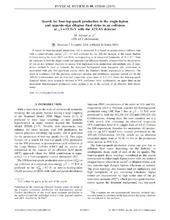Search for four-top-quark production in the single-lepton and opposite-sign dilepton final states in pp collisions at √s=13 TeV with the ATLAS detector
Aaboud, Morad; Aad, Georges; Abbott, Brad; Abdinov, Ovsat Bahram oglu; Abeloos, Baptiste; Abhayasinghe, Deshan Kavishka; Abidi, Syed Haider; AbouZeid, Hass; Abraham, Nadine L.; Abramowicz, Halina; Buanes, Trygve; Djuvsland, Julia Isabell; Eigen, Gerald; Fomin, Nikolai; Lipniacka, Anna; Martin dit Latour, Bertrand; Mæland, Steffen; Stugu, Bjarne; Yang, Zongchang; Zalieckas, Justas; Bugge, Magnar Kopangen; Cameron, David Gordon; Catmore, James Richard; Feigl, Simon; Garonne, Vincent; Gramstad, Eirik; Hellesund, Simen; Morisbak, Vanja; Oppen, Henrik; Ould-Saada, Farid; Pedersen, Maiken; Read, Alexander Lincoln; Røhne, Ole Myren; Sandaker, Heidi; Serfon, Cédric; Stapnes, Steinar; Vadla, Knut Oddvar Høie; Franconi, Laura; Abreu, Henso; Abulaiti, Yiming; Acharya, Bobby S.; Adachi, Shunsuke; Adamczyk, Leszek; Adelman, Jareed; Adersberger, Michael; Adigüzel, Aytül; Adye, Tim; Affolder, Anthony Allen; Afik, Yoav; Agheorghiesei, Catalin; ATLAS, Collaboration
Peer reviewed, Journal article
Published version

Åpne
Permanent lenke
https://hdl.handle.net/1956/23425Utgivelsesdato
2019Metadata
Vis full innførselSamlinger
Originalversjon
https://doi.org/10.1103/physrevd.99.052009Sammendrag
A search for four-top-quark production, t¯tt¯t, is presented. It is based on proton-proton collision data with a center-of-mass energy √s=13 TeV collected by the ATLAS detector at the Large Hadron Collider during the years 2015 and 2016, corresponding to an integrated luminosity of 36.1 fb−1. Data are analyzed in both the single-lepton and opposite-sign dilepton channels, characterized by the presence of one or two isolated electrons or muons with high-transverse momentum and multiple jets. A data-driven method is used to estimate the dominant background from top-quark pair production in association with jets. No significant excess above the Standard Model expectation is observed. The result is combined with the previous same-sign dilepton and multilepton searches carried out by the ATLAS Collaboration and an observed (expected) upper limit of 5.3 (2.1) times the four-top-quark Standard Model cross section is obtained at 95% confidence level. Additionally, an upper limit on the anomalous four-top-quark production cross section is set in the context of an effective field theory model.
